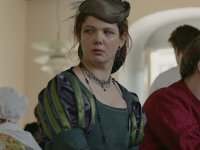My mother has always believed in having a big family Christmas. The director of a circus by profession, she brought that same organizational and creative energy into the way we celebrated the holidays. The way I remember Christmas from my childhood, it was really quite the perfect family occasion, thanks to significant collective effort.
I come from a secular family of Finnish socialists and the Christian connotations of Christmas were foreign to me when I was growing up. In Finnish, Christmas is “joulu”, a word with no inherent religious meaning. When we decorated our Christmas tree, the pride of place at the top went to the red star of communism.
Our Christmas consisted of a series of rituals. Going to the Christmas tree market with my stepfather and siblings and carrying the tree home. Bringing out the box of decorations and hanging them on the tree. The traditional Christmas breakfast, rice porridge. If you found the almond, you got to make a wish. One year my mother decided to cut down on sibling infighting by putting in enough almonds for all four of us.

Photo by Tuomas Puikkonen on Flickr. Photo has been cropped.
In Finland, we open the presents on Christmas Eve. That’s also when the most significant family dinner takes place. Nobody in our family played the role of Santa. Instead, my Mom would pretend that she’d seen Santa fly across the sky with the reindeer from a window in the furthest room in our apartment.
We ran over to look.
As we did this, my parents quickly took the giant burlap sack of Christmas presents into the hallway outside our apartment and silently closed the door. As we returned, my Mom would knock on the underside of the dinner table and say: “Did you hear that? It must be Santa at the door!”
We ran to the front door, opened it, and sure enough the presents were there!
As I grew older, my mother remarried and our group of siblings grew. I switched teams, helping my stepdad carry the sack of presents outside while my youngest siblings rushed to see Santa from the window.
The relationship I have with Christmas is positive and is not complicated at all, thanks to all the work my mother and the rest of the family put into it over the years.

Photo by Tuomas Puikkonen on Flickr.
The Training Center
In December of 2022, I played in the long-delayed Helsinki run of the larp Midwinter Revisited, with Anni Tolvanen as the project lead. The original Midwinter was created by Avalon Larp Studios and played in the U.K. in 2020, led by Martine Svanevik. Revisited was mainly created as a Finnish international production, expanded to twice the size of the original with new, redesigned and broadened content.
Midwinter Revisited is set in Santa’s Workshop. The characters are elves and Christmas is just around the corner, with everyone making sure the last gifts are produced so children everywhere will be happy and full of joy. The elves love their work and throw themselves at their long shifts with jolliness in their hearts.

Photo by Tuomas Puikkonen on Flickr.
Or put another way, the Workshop is a sweatshop where a workforce of elves is forced to endure long hours of tedious work while having to pretend they’re happy. Smiling is mandatory and those who are insufficiently jolly will be punished. Santa Claus isn’t really present in the daily lives of the elves and the Workshop is instead run by the Krampus.
The character I played was a part of this somewhat anomalous group in the larp’s structure. The word Krampus denoted an individual character, the principal villain of the larp. It also meant the collective group of characters working under her, of which I was part of. Finally, it acquired an emergent meaning as the physical location where we took recalcitrant elves for retraining. Officially called The Training Center, it was often also called just The Krampus.
The elves all dressed in Christmas gear: Lots of reds, browns and greens. The Krampus were dressed all in black, creating a striking visual contrast. Collectively, we were a cross between the wealthy family depicted in the TV show Succession and the staff of a torture facility.
There were severe class distinctions between the different elf families in Midwinter Revisited. They were made concrete by the living arrangements, with the physical location of the family’s domicile showing how wealthy they were. Still, for me as a Krampus character these distinctions were less visible because the design placed us above all of it.
The core themes of Midwinter Revisited were Christmas and capitalism. What is the meaning of Christmas? What does work mean under the demands of capitalist production? In the cosmology of the larp, the production of gifts created magical power which was hoarded by the Krampus and used to maintain control over the entire operation.

Photo by Tuomas Puikkonen on Flickr.
Sincerity
The simple genius of Midwinter Revisited lies in the way it treats Christmas with the utmost seriousness, while also leaving space to be playful. Christmas-themed movies and songs are often schmaltz or parody but this time, you as a player are really invited to consider what Christmas means for you. And not just from a political perspective, but in emotional and cultural terms as well.
What does the spirit of Christmas mean for me?
Sincerity is always difficult to pull off because it’s so close to cringe. Yet when it works, it’s very powerful. It was nice to be able to reflect on Christmas in a context that’s not saccharine, schmaltzy, or a parody, yet not without a critical edge either. What is this thing that permeates our society every year?
The way schmaltz was incorporated into Midwinter Revisited was particularly ingenious. All the tackiness of Christmas was right there, in songs, physical props, costumes and even the language we used. However, the critique of capitalism inherent in the larp’s design positioned the schmaltz for critical appraisal while also allowing us to play with it. A rare case where you manage to have your cake and eat it too.
Each of the characters belonged to a family, a work group, a club and a secret society, with the exception of the Krampus whose family was the same as the work group. This is classic larp design of course, making sure each character has a variety of social contexts.

Photo by Tuomas Puikkonen on Flickr.
One of the groups was dedicated to spiritual exploration of the meaning of Christmas. Every time I walked past the group and their collective gatherings, I felt a deep sense of larp envy. It looked so warm and communal! I considered joining in but felt that their play might be damaged by one more Krampus character.
The last hours of the larp were a chaotic, magical time. The revolt against the sweatshop capitalism of The Workshop Inc. had started but a new order was yet to form. Some were afraid, others freed by disorder. A crown of light seeming to represent the spirit of Christmas moved in the crowd creating a repeating scene of wonder and magic that felt surprisingly genuine. I had a moment with it too but I’d played a cynical Krampus character too long to be able to immediately shift gears convincingly. I felt sad afterwards because I wanted to explore that part of the larp’s emotional range more fully and didn’t entirely succeed.
When the signal for the last work shift of the larp sounded, most of the workers were on strike. Managers had to go down to the workshop to make toys, creating one of the most eerie sights of the entire larp. They were too few, too shocked, stooped under the harsh lights trying to keep the workshop running when the power they represented had already failed.

Photo by Tuomas Puikkonen on Flickr.
O Christmas Tree
Christmas is celebrated in many different countries but these celebrations are not uniform in style. What’s normal in one country is strange in the next. Midwinter Revisited was an international larp, meaning that players came from many different cultures and brought their own assumptions with them.
The variety of Christmas customs wasn’t to the detriment of the larp. Each of the three acts started with the song O Christmas Tree, the English version based on the German original, called O Tannenbaum. I felt the song worked wonderfully as an anthem for the whole larp despite the fact that it had never been part of my own Christmas tradition.
The song shares the same tune as “The Red Flag,” the U.K.’s Labour Party’s anthem, which will become relevant later.

Photo by Tuomas Puikkonen on Flickr.
The concept of jollity was central to a lot of the larp’s rhetoric. The elves were constantly exhorted to be jolly, to be happy and enjoy their work. This was a key part of the larp’s critique of modern capitalism. It wasn’t enough that you had to work. You had to enjoy it, and if someone didn’t seem to be jolly enough, that was reason to punish them. There was a department called Jollity Assurance tasked with ensuring requisite levels of jollity at all times.
I can make the connection between jollity and Christmas in the context of Anglo-American Christmas culture but not really in my own. Finnish Christmas traditions have a somber quality, meaning that in the context of our Christmas you can be happy or sad.
One of our most famous sad Christmas songs is called “Varpunen jouluaamuna,” which tells of a little bird flying, hungrily looking for food in the frozen snow fields of the Christmas morning. A little girl gives the bird a seed, only to discover that the bird is her dead brother.
Adapting to the larp’s version of Christmas wasn’t as simple as adapting to the Anglo-American version of the holiday because it had more cultural depth and variety than that. It felt like we as players from different countries were looking for a Christmas shared across our particular cultural boundaries.
The larp’s soundtrack came with an interesting twist. It wasn’t limited to English language Christmas songs but also included a Finnish song and other non-Anglo ones. When I first heard a Finnish Christmas song on the soundtrack, I experienced a moment of cultural confusion, like I was shifting from one Christmas paradigm to another.

Photo by Tuomas Puikkonen on Flickr.
This wasn’t to the detriment of the larp at all. Rather, I experienced it as a moment of reflection on what the larp meant for me. What did it mean to navigate the different conventions of my own culture and that of Anglo-American cultural imperialism? What did that mean in the specific context of Christmas, with tram stops all over Helsinki decorated with ads celebrating Coca-Cola Christmas?
The Torture Queue
Oppression play has a long history in Nordic larp. Systems of oppression create action and emotion, making for powerful and dynamic larp. If you’ve ever organized a larp with a significant element of oppression you’ve probably found out that it’s hard work. People don’t oppress themselves! You have to put in the work to really make an oppressive system run.
One facet of this is when you create a system where a police force (The Reindeer Guard in this larp) arrest people and drag them to a punishment center. This can be a torture chamber, a prison, an interrogation or what have you, depending on the larp.
Running one of these centers in a larp is an art unto its own. There are many difficulties to consider. Experienced Nordic larpers often regard being interrogated or tortured as interesting larp content. Many steer their play purposefully towards it. In some larps, this has resulted in what is colloquially known as the “torture queue”. Because torture capacity is limited, characters and players have to wait before they can be tortured.
This is just simple logistics. If there are two torturers and a single torture scene lasts for an hour, this means that the larp can only accommodate torture scenes for two players every hour. If the larp has 100 players, this creates a significant bottleneck. Some players will miss out on the torture.

Photo by Tuomas Puikkonen on Flickr.
To resolve this issue, Midwinter Revisited’s design gave us in the Krampus our own space, the Training Center, a big classroom-like area with chairs and desks as well as a raised platform where we had our own luxurious Christmas tree, piles of presents and a table full of interesting knickknacks. The idea was that the Krampus characters were the only ones to be able to enjoy a luxurious family Christmas, and the elves being re-educated had to watch.
The point of the classroom setting was to do big oppression scenes, where one Krampus player could handle as many as six or even ten characters simultaneously. This way, the torture queue would not happen because scenes could roll all continuously, for as many characters as needed.
In practice, it didn’t really work out like this. For much of the larp, the Training Center wasn’t training anyone. We had the opposite problem from the torture queue: Often it was difficult to get people to come in at all.
I figured there were a few different reasons why this was. There were a lot of first time players at the larp and maybe it wasn’t obvious to them that playing oppression scenes is fun. That’s more of an experienced Nordic larper thing. Some players and characters may have tried to avoid getting tortured, as amazing as that sounds.
Some may have wanted an intimate one-on-one torture scene, and when that wasn’t in the cards, lost interest.

Photo by Tuomas Puikkonen on Flickr.
It was very difficult for us in the Krampus to draw victims in. The process involved tasking the Reindeer Guard with arresting individual elves and bringing them to us. Because we wanted to make larger scenes of oppression, the arrest lists we drew up often had five or six names.
The problems this situation created were many. Because the Krampus was somewhat separate from the rest of the larp, we often simply didn’t know what was happening. Because of this, it was often difficult to know who needed to be arrested.
It was very difficult for the Reindeer Guard to arrest multiple characters quickly. I’ve seen this issue in other larps as well. Going around the larp with a list of names and trying to find the right people takes time and often fails entirely due to larp chaos. Thus, I ended up giving the Reindeer Guard tasks that were either very difficult or actually impossible for them to fulfill.
The logistical problems of oppression play are absolutely not unique to Midwinter Revisited and many great scenes were played. The structural idea of scaling up the machinery of oppression was a good one.

Photo by Tuomas Puikkonen on Flickr.
Red Christmas
In the larp’s third and final act, it was clear the revolution was upon us. The question was which way would it go. Will the old status quo be restored, will a paternal figure like Santa Claus (or a maternal figure like the Krampus) emerge or will the revolution lead to a workers’ paradise?
For my character, this was rather anxiety-inducing as I was part of the machinery of oppression. My character was a medical doctor of sorts and I spent much of the larp dispensing and withholding Jollity Pills, an all-purpose drug that could be amphetamines, antibiotics or a miracle cure. As a medical torturer, at first glance it didn’t look like I’d fare very well under the new worker-led regime.
I had a scene with another Krampus character where we talked about our worries for the future and the line we held onto was this one: “No matter who ends up in power, they’ll always need people like us.” Of course, the fiction of the larp ends when the larp ends, so the future of our characters remains unknowable, as it should be.

Photo by Tuomas Puikkonen on Flickr.
Midwinter Revisited had a mechanism where players could mark which Christmas ideology their character subscribed to at the end. White for a corporate option where Christmas is controlled by a company or a foundation run by the elves. Green for a religious or royalist wish to see a figure like Santa Claus or the Krampus returned to the top. Red for a Christmas not controlled by any one entity, but instead owned collectively.
White would have been the obvious choice for me but I decided late in the larp that I needed a bit of character development to keep things interesting. I felt that my character was a born lackey so in a situation where the old order was crumbling, the green option was the most promising one. It still suggested that there would be power to serve.
The way it would work was that the central visual motif of the larp, the grand Christmas tree, would be lit one of the three colors, depending on which way the larp went. The moment when the song O Christmas Tree played, only to suddenly switch to The Red Flag as the tree was bathed in red light was very powerful. The musical switch was rather elegant because the songs shared the same tune. And of course, the red Christmas was familiar to me from my childhood already.
As a player, it was the ending I wished for, despite my character’s royalist hopes. A Christmas we can all believe in!

Photo by Tuomas Puikkonen on Flickr.
Credits
Midwinter Revisited is a redesigned and extended edition of the larp Midwinter, originally run by by Avalon Larp Studio in Birmingham, UK, in January 2020. The original design was envisioned and directed by Martine Svanevik.
Midwinter Revisited is an independent piece based on the original work.
The Workshop, Inc. Helsinki Division
Production and design lead, sound design: Anni Tolvanen
Narrative and character design: Simon Brind
Narrative and runtime design: Johana Koljonen
Character design, production coordination: Irrette Melakoski
Scenography: Katie Ballinger, Mikko Asunta, Tina Aspiala
Lighting: Eleanor Saitta
Kitchen: Paula Susitaival, Kristiina Prauda
Player support: Juha Hurme
Photography: Tuomas Puikkonen
Writing and runtime facilitation: Kol Ford, William Hagstedt, Char Holdway, Torgrim Husvik, Jamie MacDonald, Maria Pettersson, Rebel Rehbinder, Jørn Slemdal, Kaya Toft Thejls
Cover photo: Tuomas Puikkonen on Flickr. Photo has been cropped.






